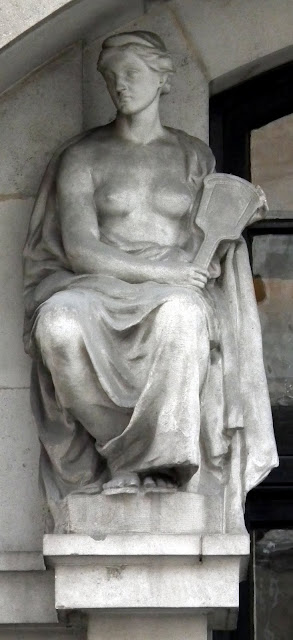 |
| Truth |
 |
| Justice |
The Law Society's building is a history of expansion as lawyers became the secret rulers of the universe in the course of the 19th and 20th centuries. The centre was built by Lewis Vulliamy in 1829. Wings were added on either side in 1848 and 1856, and in 1902 a big block to the north by one of the best architects of the early 20th century, Charles Holden.
Holden was in his late 20s when he created the austere block ornamented only by four allegorical figures of bare-breasted women by Charles Pibworth, who was just 24.
The figures on Chancery Lane represent Truth with a mirror and Justice with scales, sword and (erroneously) blindfold. They are severe, strong and clean-lined.
 |
| Mercy |
Pibworth's figures on the Carey Street front are of Mercy holding fruit including grapes and apples and Liberty wearing a Phrygian cap and carrying a sheathed sword.
Holden commissioned Pibworth almost immediately to work on Bristol Central Public Library where he designed a number of historical figures, but after that Holden turned to more avant garde sculptors, notably Epstein and Gill.
A shame really. Pibworth's figures have a nobility that graces the building.
The pride of lions on the railings at the front are incomers, brought here from the British Museum. They were the first castings of an image known in heraldry as lions sejant (lions sitting, something lions never do in nature), by Alfred Stevens (1817-1875), one of those artists who produced surprisingly little but had a massive influence on others. He is mainly remembered today for his conviction that a true artist can produce art in any medium.
The lions were created to decorate a line of posts outside the British Museum but they were later removed in some sort of pavement improvement programme. Some were placed round the Wellington monument and others on the railings in front of the Law Society building. The original model is outside the Royal British Society of Sculptors.
The figure soon became a cliche of the garden ornament business. In Victorian times, the Covent Garden firm of Brucciani & Co. made bronze casts which were sold for 7s. 6d. each. Pilkington's Tile and Pottery Company and Carter & Co of Poole made earthenware versions around 1900.
Holden commissioned Pibworth almost immediately to work on Bristol Central Public Library where he designed a number of historical figures, but after that Holden turned to more avant garde sculptors, notably Epstein and Gill.
A shame really. Pibworth's figures have a nobility that graces the building.
The pride of lions on the railings at the front are incomers, brought here from the British Museum. They were the first castings of an image known in heraldry as lions sejant (lions sitting, something lions never do in nature), by Alfred Stevens (1817-1875), one of those artists who produced surprisingly little but had a massive influence on others. He is mainly remembered today for his conviction that a true artist can produce art in any medium.
The lions were created to decorate a line of posts outside the British Museum but they were later removed in some sort of pavement improvement programme. Some were placed round the Wellington monument and others on the railings in front of the Law Society building. The original model is outside the Royal British Society of Sculptors.
 |
| Yes, that is my bike. |
The inexorable decay from new and vibrant art object to tired, reproduction-of-reproduction commercial tat is admirably chronicled by Peter Berthoud at Discovering London.




2 comments:
I think you will find that the lady with the mirror is Prudence, defined as the ability to see oneself. I think this was discussed at some length when you featured the Prudential Building in Holborn a long time ago. "Truth" is the sword that is held by Justice.
When I first saw here I thought that it was our old friend Prudentia too, but what we can't see in the picture is that the artist has carved the word 'Truth' in the plinth she is sitting on.
Post a Comment